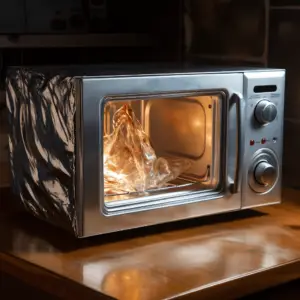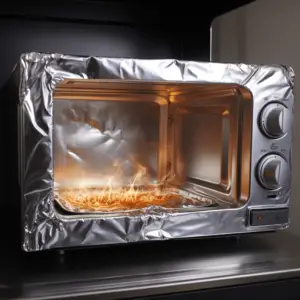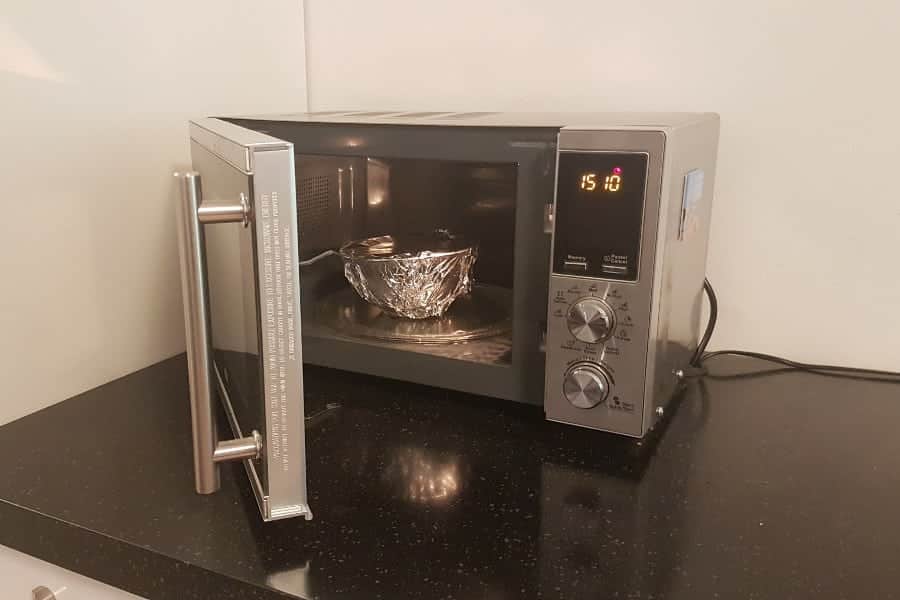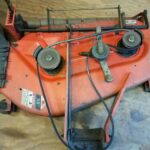Convection Microwaves can put foil paper in a convection microwave but as is with everything that works, there are guidelines and restrictions that must be heeded to avoid unnecessary accidents or damage to your microwave.
Innovation leads to smarter equipment and gadgets. The convection microwave is one of your best kitchen purchases in recent years. The culinary community has enjoyed it. While a standard microwave may handle most of your heating needs, a convection microwave’s versatility is the main reason to get one.
You can do more than ‘nuke’ cold food in a convection microwave. Roast meats and tubers, bake pastries, casseroles, and entire vegetables, boil and thicken gravies, and heat or cook pizza. Aluminum foil is essential for cooking, packing, and keeping food. You’ve probably put foil-wrapped food in your convection microwave and wondered if it was safe. Opposing opinions exist, but specifics matter.
Table of Contents
How to use foil in a convection microwave

Aluminum foil is not combustible at kitchen or microwave temperatures, contrary to popular belief.Aluminum foil melts at 1220 degrees Fahrenheit or 660 degrees Celsius.
That said, the reason spontaneous ignition at times occurs when the foil is used in the microwave is that it is used wrong. If you must use foil in the microwave below are the general guidelines.
Do not cover or wrap food completely with foil when heating or cooking it in the microwave
A high-velocity fan spreads heat from the heating coil across the microwave chamber of a convection microwave, heating or cooking food evenly.Due to its heat resistance, aluminum food wraps don’t heat up.
Wrap only the sections of the meal that need minimal or no heat in aluminum foil for convection microwaves.
These could be chicken leg and wing tips. Wrap them firmly in foil to prevent overbrowning while the rest of the food is exposed to the chamber’s heat.
Ensure there are no hanging pieces of foil
Foil is metal and hanging tips or pointy edges will act as an antenna for the electromagnetic waves that emit from the magnetron of the microwave. This will cause electrical sparks and arcing and your microwave could ignite as a result.
Keep foil tightly secured against its contents to avoid this problem.
Only use aluminum foil to line the floor of the cooking dish
In a convection oven, lining your cooking dish with aluminum can produce a perfectly cooked meal especially roasts and pastries.
The fact that aluminum is impervious to heat means that when it lines the bottom of your cooking pan, it will not absorb heat and transfer it to the food which would likely burn at the point of contact with the dish.
The even heat spread in a convection oven will only affect the food and not the aluminum lining, so your roast won’t burn on the bottom.
Because of this, most fast food is served on aluminum-coated paper plates that can be heated in the microwave. Food can be cooked safely in a convection microwave as long as it is not covered or you don’t use a “microwave cover.”
The metal plate doesn’t have any sharp edges or points that could cause arcing, so the heat doesn’t hurt the food. Even though the food is getting very hot, the metal plate is still cool to the touch.
In a convection microwave, aluminum foil is a great way to hold food or cover plates.
Aluminum pans
Aluminum is the best metal for frying pans and has been for generations. Even without foil, aluminum is the greatest material for roasting, baking, and boiling in a convection microwave and most other kitchen appliances.
Aluminum foil may seem unusual for convection microwaves, but there are pans created for them to eliminate foil mistakes.
About Convection Microwaves

The convection microwave is the hybrid product of a regular microwave and a conventional oven. The convection microwave combines the mechanisms of precise heating and heat distribution creating an effective multipurpose cooking tool.
The size of a convection microwave may prevent it from holding as much food as an oven. Adding an oven may be wise.
Conversely, for a tiny kitchen or little meals, a convection oven is the best way to quickly and efficiently prepare great dishes that are difficult to cook on a stovetop or oven. Convection microwaves cost more than normal microwaves, but its versatility justifies the additional price.
Finally
Understanding how appliances function is vital to avoid damaging them, especially those built to last decades. If not, following the manufacturer’s instructions should help you use your equipment properly and ensure its long-term usefulness.


